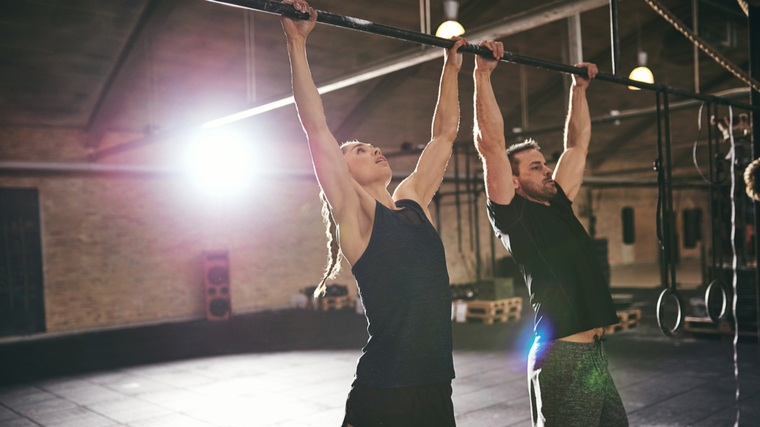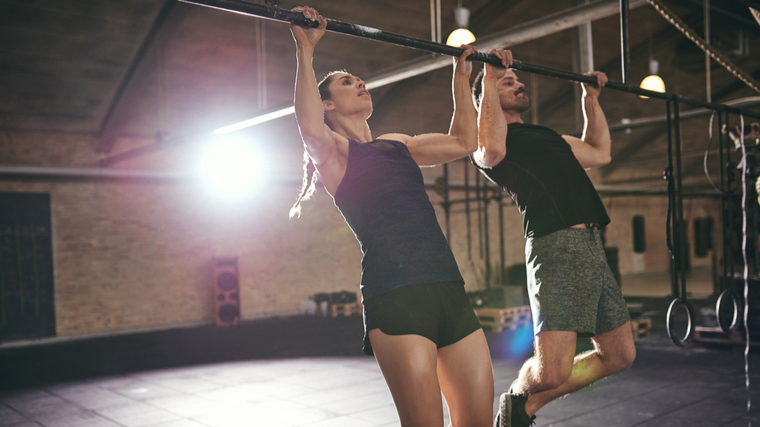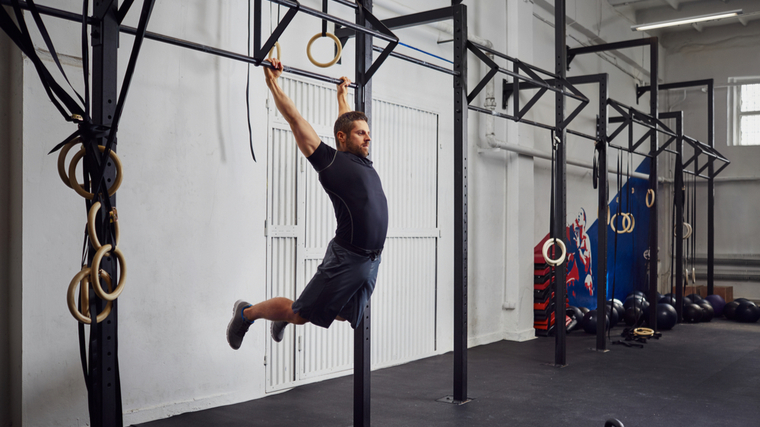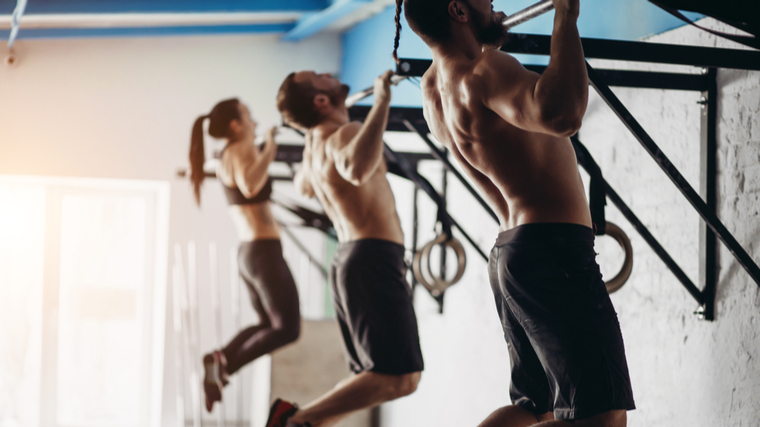The pull-up is the meat and potatoes of any back workout. It’s one of the few exercises that nearly every experienced lifter agrees is essential for building a foundation of size and strength. You’ll find it performed and praised by bodybuilders, strength athletes, and traditional sports athletes due to its wide benefits.
This battle-tested exercise is unique since it delivers a stronger back and abs for huge carryover to almost every other major lift. Plus, bigger muscles in the back, shoulders, and arms will improve any physique. All while using only your bodyweight. You don’t need a gym to find plenty of gains.
- How to Do the Pull-Up
- Pull-Up Mistakes to Avoid
- Benefits of the Pull-Up
- Muscles Worked by the Pull-Up
- Who Should Do the Pull-Up
- How to Program the Pull-Up
- Pull-Up Variations
- Pull-Up Alternatives
- Frequently Asked Questions
How to Do the Pull-Up
Pull-ups are a great addition to any strength program. The simple movement of lifting yourself up to a bar will provide a great range of benefits that assist in general strength, posture, and core stability.
Step 1 — Hang From a Bar

Start hanging from a straight bar with your core stabilized to prevent your body from swaying. Set your hands so they’re a smidge wider than shoulder-width using a pronated (overhand or palms down) grip. To maintain balance and coordination, you can cross one foot over the other at your ankles.
Form Tip: When stabilizing your core, imagine someone is about to punch you in the stomach. The initial flinch of tightening your stomach will place you in an effective bracing position.
Step 2 — Pull Your Chest Towards the Bar

Take a breath before beginning to pull yourself towards the bar. Pull your shoulder blades together to recruit your upper back muscles. Maintain that squeeze while bending your elbows to raise your body. Exhale throughout the movement. Lean back very slightly on the way up.
When your neck is near the bar, you’ve completed the concentric (pulling) portion of the rep. In the top position, your torso should be angled slightly backwards with your elbows near your ribs.
Form Tip: To improve muscle coordination and muscle fiber recruitment, pause at the top for one or two seconds.
Step 3 — Lower Under Control

Start the eccentric (lowering) portion of the rep by extending your elbows to lower your body. Breathe in and keep your core engaged. Do not swing to create momentum between each rep. Keep your legs hanging directly down.
Form Tip:To improve the quality of each rep and prevent any swaying, lower yourself over two seconds and pause at the bottom before beginning the next rep.
Pull-Up Mistakes to Avoid
The pull-up is a basic bodyweight exercise, but there are several common technique errors to avoid in order to build strength and muscle while reducing joint strain.
Not Using a Full Range of Motion
The half-rep pull-up is an all too common issue seen in many gyms. Some lifters smash out rep after rep while only descending halfway down before rushing straight back to the top. When it comes to maximizing strength and muscle gains, these half-reps are counterproductive.

The shortened range of motion reduces the muscle’s time under tension, which can reduce muscle growth and strength development.
Avoid it: Leave your ego at the door and focus on quality reps over quantity. Lower yourself into a fully stretched position before re-engaging your muscles to lift yourself back up.
Excessive Swinging
Stabilizing the body is crucial for minimizing stress on the shoulder joint. If you are trying to build strength and muscle, using an excessive amount of swinging is not going to help and may make things worse in the long run.

CrossFit training has popularized “kipping pull-ups”, a specific exercise variation which has the trainee deliberately swing the lower body back and forth throughout each rep. This generates momentum which helps to perform high-rep sets and turns the back-building pull-up into a full-body exercise. Kipping is a specific technique used for a specific purpose. It’s also a deliberately learned skill, it’s not meant to be an accidental way to perform basic pull-ups.
Avoid it: Focus on the core-engaging cue explained in step one of the setup. While hanging and before pulling, flex your stomach as if you were about to be punched in the gut. Maintain this ab tension throughout each rep.
Benefits of the Pull-Up
The pull-up is a second-to-none vertical pulling exercise. When performed correctly, it can emphasize the development of strength and muscle across the entire upper body, support overall posture, and help general shoulder and upper back mobility.

Getting Bigger and Stronger
Because so many muscles are involved in the exercise, the pull-up delivers a serious bang for your buck. This one movement builds muscle through the entire back, shoulders, and arms. Even the abs get a solid workout. It is also a very easy exercise to progressively overload (make more challenging, often with added weight), which makes the exercise ideal for building strength.
Carries Over to Multiple Exercises
The pull-up recruits and builds muscles which play key roles in many other lifts. Strengthening these support muscles translates to improvement in other exercises. For example, strengthening the lats, upper back, and middle back can carryover to the bench press where you need to retract your shoulder blades into the bench to create stability and control when pressing a heavy weight.
Better Grip Strength
While there are specific exercises to build a stronger grip, simply performing the pull-up strengthens your forearms and grip without additional wear and tear that may occur from more grip-focused exercises like the deadlift. Because you’re hanging from the bar supporting your bodyweight during each set, your grip strength is being consistently trained from the first rep to the last.
Muscles Worked by Pull-Up
The pull-up is a compound movement, meaning it involves multiple joints and recruits multiple muscle groups at once. Here’s a breakdown of the muscles worked by the pull-up.

Latissimus Dorsi
The lats are the largest back muscle, attaching at the upper arm and along the spine near the lower back. They serve two primary functions. First, they bring the arm closer to the body from out to the side. Second, they bring the arm closer to the body from out in front. This is why the lats are heavily activated when your arms begin overhead and pull down and in to raise your body during a pull-up.
Upper Back
The upper back (generally including the rear deltoid of the shoulder, the trapezius, and the rhomboids) functions to control movement of the scapulae (shoulder blades) and to support the shoulder joints under muscular stress, particularly in the bottom portion of the pull-up.
Trapezius
While sections of the traps fall into the “upper back” category, the trapezius is a large muscle on its own and serves a big role during pull-ups. The middle portion of the traps help to pull your shoulders back while extending your elbows behind you while also stabilizing your shoulders when you move your arms.Your lower traps are crucial to many other lifts and are highly activated during pull-ups. (1)
Biceps Brachii
The biceps are composed of two heads: a long head commonly referred to as the “outer” and a short head referred to as the “inner.” Both muscle heads originate at the scapulae and insert on the radius bone of the forearm. The biceps play a relatively smaller, but important, role during pull-ups to complete the top part of the movement. They are more significantly activated and play a larger role in the chin-up variation.
Lower Back
The muscles of the lower back, or lumbar spine, have been shown to be recruited during pull-ups even though they aren’t moved through a significant range of motion. Because these muscles control your torso bending at the hips, they work during the exercise to maintain a stable core position and keep a straight line from your shoulders to your knees or feet.
Rectus Abdominis
The abs are surprisingly worked to a very significant degree during pull-ups. While most lifters are more familiar with the abs’ role in flexing your torso in a curled position, they’re highly activated to maintain a stiff, solid torso. Similar to the lower back, the abs work to prevent bending at the hips.
Who Should Do the Pull-Up
Training for Bodyweight Strength
Many bodyweight training-focused lifters consider the pull-up to be an essential test of strength. Because strength is a skill, if you want to improve your pull-up numbers, you need to get better at the exercise itself. This skill comes from repeated efforts, rep after rep.
Training for Muscle
To increase muscularity, the pull-up should be a recurring movement in your workouts. The activation of multiple muscles combined with a long range of motion provide a muscle-building stimulus that very few upper body exercises can match.
How to Program the Pull-Up
The pull-up can be programmed with a variety of sets, reps, and tempo schemes. The exercise is ideally performed at the beginning of your workout. This will make sure your body has the energy required to perform this comprehensive movement without sacrificing your technique or increasing injury risk.
Weighted, Low Repetition
To maximize basic strength in the pull-up, completing four to six sets in the three to six rep range is the place to start. Use a weight that leaves you with at least two reps left “in the tank” to avoid reaching muscular failure. A rest period of three to five minutes between each set will ensure you lift with maximum effort.
However, to ensure proper technique, you should only add weight once you can comfortably handle moderate to high-rep sets using your bodyweight.
Unweighted, Moderate Repetition
To ensure growth in the working muscles, three to four sets in the six to 12 rep range will increase overall training volume, which is beneficial for building muscle. (2) The multiple sets and reps also allow you to improve your pull-up technique.
Modified Cluster Sets
Some lifters, especially beginners, may not be able to perform pull-ups for multiple sets of multiple reps. Even performing one or two reps may be challenging. This is where cluster sets are beneficial. Cluster sets allow a lifter to perform multiple low-rep “mini-sets” (or clusters) with a heavy weight while avoiding excessive muscular fatigue. You can apply the same technique to bodyweight pull-ups.
This modified cluster set method will have three sets of three reps in one cluster (if you can currently perform four or five reps with good form). Perform three reps, rest for 15 to 30 seconds, perform another three reps, rest for 15 to 30 seconds, and perform a final group of three reps. That entire series is one set. Take two minutes rest before repeating two more sets.
Because three sets of three cluster reps is comparable to performing nine reps in a single set. This will allow you to get stronger, maximize the recruitment of high-threshold muscle fibers (specialized muscle fibers which improve power output), and increase total working volume which can lead to more muscle.
Note: If you cannot perform three reps with good technique, you can use the cluster set method while performing one or two reps per cluster.
Pull-Up Variations
The basic pull-up is staple in many experienced lifters’ routines, but simple variations can be used for specific goals. Even after you’ve mastered the pull-up, you can implement some of these variations into your training.
Negative Pull-Ups
To perform negative pull-ups, you will need to stand on a box or bench under a pull-up bar. Take hold of the bar with a basic shoulder-width grip and jump up to get your chin above the bar.
Take at least five seconds to lower yourself into the stretched position. Once fully stretched, put your feet on the box again, return to the top position, and repeat until you hit your target rep range.
Chin-Up
One of the most basic pull-up variations is simply reversing your grip. By grabbing the bar with a supinated (underhand or palm-up) grip, you more directly recruit the biceps.
This makes the exercise fit very well into a specific arm workout or it can add “extra” arm training to your back workout.
Wide-Grip Pull-Up
The wide-grip pull-up requires grabbing the bar several inches wider than shoulder-width. Pull yourself up as high as possible and lower yourself under complete control.
The different grip changes the arm position overhead, which changes the range of motion and puts the lats, upper back, and biceps under a different angle of stretch, which creates a unique training stimulus.
Pull-Up Alternatives
You might not be ready to complete a full set of pull-ups, which is no big deal because we all start somewhere. The first priority is understanding the prime movers involved in the pull-up and how to strengthen them. The muscles most activated in the pull-up are the lats, mid and lower traps, biceps, and your core. (3) The following exercises will help you build strength in these important muscle groups.
Scapula Pull-Ups
Scapula pull-ups can help strengthen your grip and lower traps which both play a large role in performing the full pull-up effectively.
Start by hanging from the bar with a shoulder-width grip. Keep your shoulders “shrugged” down away from your ears. Without bending at your elbows, pull your scapulae downwards while pulling your body up. It’s a very short but impactful range of motion. Hold for a slight pause at the top and lower yourself slowly by allowing your scapula to “open up” until you are at a full stretch.
To progress, start by increasing the amount of reps done in each set until you can handle 12 to 15. Once mastered, this exercise can be used within your general warm-up sequence before full pull-ups.
Kneeling Lat Pulldowns
The kneeling lat pulldown will help strengthen the lats, core, and biceps. Use a cable machine, kneeling on the ground while mimicking the exact same starting position as you would for the pull-up.
Keep yourself upright with your glutes flexed to provide stability and increase core activation. Every muscle must remain tight from the ground up.
To progress, you can introduce one and one-half reps — one full rep includes pulling all the way down, releasing the weight halfway up, pulling down again, and releasing to a full stretch. This is a great technique that can be used to emphasize the tension placed on the muscles from both the start of the pull-up and the end of the pull-up.
Inverted Row
The inverted row will help to strengthen the pulling strength of your lats, core, and arms while also emphasizing the mid-traps and upper back. A Smith machine is perfect for this exercise since you can easily adjust the height of the bar while also being in a stable, fixed position.
To progress, lower the height of the bar to adjust leverage and increase the challenge. Eventually you can elevate your feet to put your entire body into a more horizontal position.
Banded Pull-Ups
The banded pull-up is a great way to improve your muscle coordination from a neurological standpoint since strength is a skill built on repetition. (4) The banded pull-up is going to allow you to better prepare yourself to perform the concentric (pulling) portion of the movement since the bands will assist your strength in the bottom position.
Attach a resistance band to the top of a bar and get yourself into position with the band supporting your body, either with bent knees or keeping your legs straight.
To progress, make your way up resistance bands offering less resistance until you are ready to perform your pull-ups with full bodyweight.
FAQs
Can I get a six-pack from doing pull-ups?
No single exercise can give you a six-pack. That can only be achieved through a reduction in body fat, fat loss-focused training, and a calorie-controlled nutrition plan.
With that being said, pull-ups may help with improving the final look of your abs because they are heavily recruited during the exercise, as explained in the muscles-worked section. Pull-ups are an awesome and overlooked exercise for training your abs. You can expect a more prominent set of abs once you do get lean enough.
When can I start performing weighted pull-ups?
The exact timeframe can vary from individual to individual since some people are capable of performing pull-ups in a very short time. However, once you can accomplish three to four sets of 12 reps using your bodyweight, you’ve likely built the technique, coordination, and strength to tackle low-rep weighted pull-ups.
How many times per week should I perform pull-ups?
For building strength and muscle, and taking into consideration the recovery ability of the involved muscle groups, performing this exercise twice per week will be the best place to start. (5) Make sure to give yourself at least two or three days rest between workouts.
For the purpose of getting more technique practice and perfecting this movement, you can implement bodyweight pull-ups as a part of your general warm-up for upper body workouts or even for workouts where a back-focused exercise like the deadlift may be performed. The aim for this technique training would be not to fatigue your back muscles, but to mobilize and activate the associated muscles that are going to be used in those workouts..
References
- Youdas JW, Amundson CL, Cicero KS, Hahn JJ, Harezlak DT, Hollman JH. Surface electromyographic activation patterns and elbow joint motion during a pull-up, chin-up, or perfect-pullup™ rotational exercise. J Strength Cond Res. 2010 Dec;24(12):3404-14. doi: 10.1519/JSC.0b013e3181f1598c. PMID: 21068680.
- Schoenfeld BJ, Contreras B, Krieger J, et al. Resistance Training Volume Enhances Muscle Hypertrophy but Not Strength in Trained Men. Med Sci Sports Exerc. 2019;51(1):94-103. doi:10.1249/MSS.0000000000001764
- Hewit, Jennifer. (2018). A Comparison of Muscle Activation during the Pull-up and Three Alternative Pulling Exercises. Journal of Physical Fitness, Medicine & Treatment in Sports. 5. 10.19080/JPFMTS.2018.05.555669.
- Ochi, E., Maruo, M., Tsuchiya, Y., Ishii, N., Miura, K., & Sasaki, K. (2018). Higher Training Frequency Is Important for Gaining Muscular Strength Under Volume-Matched Training. Frontiers in physiology, 9, 744. https://doi.org/10.3389/fphys.2018.00744
- Schoenfeld, B. J., Ogborn, D., & Krieger, J. W. (2016). Effects of Resistance Training Frequency on Measures of Muscle Hypertrophy: A Systematic Review and Meta-Analysis. Sports medicine (Auckland, N.Z.), 46(11), 1689–1697. https://doi.org/10.1007/s40279-016-0543-8
Featured Image: UfaBizPhoto / Shutterstock






